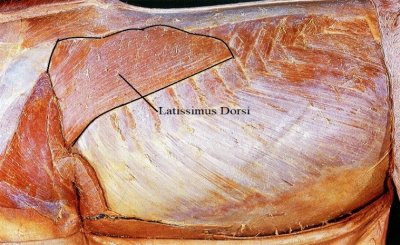Reflocking; Really?
Reflocking; Really?
by Jean Luc Cornille
“Adjustments to muscular changes can be made via adjusting the wool flocking on a regular schedule.”
The ones who state what they think is true, rarely provide evidences. The science of motion instead, questions traditional as well as unproven beliefs, in the light of new knowledge. We provide, paraphrasing Paul Graham (Seven levels of a disagreement hierarchy,) a pin for popping such balloons.
Under the skin, lies the cutaneous trunci. The muscle covers the entire body. It is the muscle that the horse shakes to remove a fly. Superficially, the muscle is closely adherent to the dermis. Deep to it, the superficial fascia contains extensive fat deposit. 

The saddle rests on the cutaneous trunci suggesting that adjusting the wool flocking might fit the fat deposit before muscular changes occurring underneath.
 The cutaneous trunci, which has been moved on this picture, is quite thick.
The cutaneous trunci, which has been moved on this picture, is quite thick.
One inch in average, up to two inches at some places.

The trapezius thoracis, which is underlined with a black line on this picture, is often emphasized in saddle fitting theories as a reason to place the saddle further back on the horse thoracolumbar column.
The thought of “liberating the shoulders’ is over exploited. Properly placed, the saddle does cover, without nuisance, the caudal part of the trapezius.

We will explain, as we go on with this dynamics analysis that
moving the saddle too far back does induces abnormal pressure on the
thoracic vertebrae behind the wither.
Indeed, if one wants to place the saddle behind the trapezius thoracis, one will have to place the saddle very far back.

The latissimus dorsi is a much bigger muscle moving the scapula-humeral frame backward during the stance or propulsive phase. The muscle is inevitably under the saddle but also under the cutaneous trunci.
The latissimus dorsi is quite thick, as illustrated on this picture where the latissimus dorsi has been removed, 
showing two sections underlines in black, where the latissimus dorsi have been cut.
By comparison, the trapezius thoracic is not very thick.

The muscles which really move the thoracolumbar column, the longissimus thoracis, (thoracic element of the longissimus dorsi,) is situated deeper under.
The saddle needs to fit the lateroflexions, transversal rotations and dorso-ventral flexions that these muscles create.
The stability of the saddle, the capacity of the saddle to remain stable whatever the horse move, the accuracy of the saddle and therefore the absence of shifts or any movements distorting the precise relation between the horse’s thoracolumbar spine and the rider’s vertebral column, is what saddle fitting is about. This the dynamic perspective that this talk is going to explain.
Jean Luc


 twitter
twitter pinterest
pinterest linkedin
linkedin